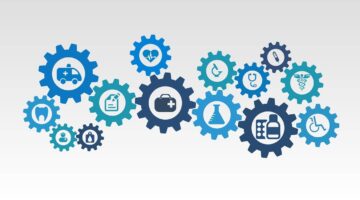
African woman opening parcel with meal kit.
The impact of Covid-19 on the health of minorities is staggering. According to the Centers for Disease Control and Prevention, Black and Brown communities experience hospitalization or death from Covid-19 at rates 4-5 times greater than Caucasians. The unfortunate truth is that race and ethnicity influence a person’s health. Minorities typically have less access to medical testing and treatment and are more likely to face poorer health outcomes. Yet access to quality healthcare is not the only barrier to wellbeing for people of racial and ethnic minorities. Social disparities are rampant among minority communities and have a significant and long-lasting negative impact on a person’s overall health and wellbeing.
Holes in the social safety net
In many communities, and especially among minorities, there are gaping holes in the social safety net. Many individuals lack access to high-quality education, safe neighborhoods, affordable housing, reliable transportation, clean environments, nutritious food and stable employment. Ultimately, their health is adversely impacted by their social circumstances. Without transportation, a person may not be able to get to the doctor, to childcare services, or to a local market to purchase fresh food. Without education, a person may not understand their health condition or know they are experiencing symptoms of a serious illness or where to go for testing or treatment. And without housing, they may be unable to stay safe.

Solera Health’s Playbook To Beat Rising Employer Expenses
Solera Health is working to streamline employer contracting with health tech.
We’ve known for years that access to basic social needs impacts a person’s health. Today, the Covid-19 pandemic is shining a light on the link between social disparities and health outcomes and exacerbating issues for vulnerable populations that are already struggling. As the number of Covid-19 infections continue to rise and economic hardships surge, now is the time to invest in community-based services that right the wrongs of social disparities among minorities.
Forging community connections
We need robust data-sharing and community networks that allow us to better understand social needs at the community and individual levels, and an infrastructure that enables healthcare and social services providers to better coordinate medical and social care. Bridging that gap will require input, resources, commitment and collaboration from multiple stakeholders: payers, providers, policymakers and community service organizations.
The most important of these groups is community-based organizations. Collaboration with community-based organizations is critical if we really want to address the indirect conditions – the social determinants of health – that affect health equity. Food banks, job placement services, childcare providers and other local community organizations are best poised to understand the needs of their community members and to help reach people in need where they live. This is especially important for healthcare organizations to understand: they alone are not able to address health inequities.
Health systems and insurance plans are being tasked with responding to changing medical needs to ensure that all their members have access to timely quality care and support services. And many state and national legislators are working to improve care through policy changes. But to truly effect change, payers, providers and policymakers must work hand-in-hand with community advocates to address racial social and health disparities. Increasing access to telemedicine services and testing locations is not enough. They must reach out to their communities to better understand the needs of their members beyond healthcare and forge relationships to find solutions to address them.
Lessons from Kansas City
One example of a community that has made great strides in helping address social and health disparities is Kansas City. As the pandemic began and unemployment skyrocketed, food insecurity increased dramatically. Community organizations throughout the city quickly realized that a lack of existing infrastructure made meal delivery to people in need an enormous challenge. Many of Kansas City’s critical food suppliers and food banks were not set up for a delivery model, required because of social distancing requirements and the closing of senior community centers in response to the pandemic, leaving a surplus of food in storage and many residents without access to much-needed nutrition.
A coalition of nonprofits, transportation and technology providers, and healthcare organizations helped coordinate seamless, contactless distribution of food to people facing food insecurity. Grants to support relief efforts were provided to community organizations to coordinate the delivery of food to households in need via transportation providers. Through these resources and partnerships, the local food banks have been able to increase capacity and ensure that people in need have healthy meals delivered right to their door.
Communities across the country can learn a great deal from Kansas City. In particular, the importance of gathering intelligence around and understanding the social needs of their people. Another important lesson is reaching out beyond your own walls to build a network that draws on resources and expertise from various stakeholders to address disparities through targeted, coordinated interventions.
Enacting meaningful change
There is more to health than healthcare, and the spread of Covid-19 in the U.S. has made stark how our fragmented care systems leaves our most vulnerable community members at heightened risk. Unfortunately, the pandemic has disproportionately affected populations, in particular Black and Brown communities, who contribute to a majority of service industry jobs that have been heavily affected by unemployment or are at an increased risk of contracting the virus. There is a clear need to invest in social service organizations to address social and economic issues to improve the health and wellbeing of our most vulnerable populations and enable these populations to recover.
Radically improving health outcomes for vulnerable populations requires a multifaceted proactive, community-wide approach focused on better understanding social determinants of health and simultaneously addressing social and health inequalities. Equally important is the need to increase capacity for social services and funding for community-level support systems to ensure we can address gaps in both social needs and healthcare. Action needs to happen now to invest in community services to make racial health equity achievable and sustainable.
Photo: vgajic, Getty Images
Manik Bhat is the Founder and Chief Executive Officer of Healthify. He was moved to create Healthify in 2013 while working as a community health worker in East Baltimore, where he saw how social needs dramatically impacted health outcomes in the community. Manik is an advocate for addressing the social determinants of health through equitable and collaborative partnerships between healthcare and social service organizations
This post appears through the MedCity Influencers program. Anyone can publish their perspective on business and innovation in healthcare on MedCity News through MedCity Influencers. Click here to find out how.








